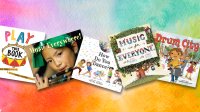Let’s Dance! Get Your Students Moving
These picture books help early learners release their bottled-up energy at the end of the day, or throughout the day during transitions.
Your content has been saved!
Go to My Saved Content.At the end of a school day, sometimes students just need a dance party. Full disclosure: Sometimes teachers need a dance party. Kindergarten dance parties were not part of any lesson plan or an item on the daily schedule, but after teaching for many years, I was able to anticipate when the classroom might need a dance break: Most of the time it was at the end of a long day.
Frequently, this was the scenario: The classroom seemed to vibrate with pent-up energy; students were antsy and grumpy. Handing this group of students off to parents and caregivers would be a recipe for disaster. The typical end-of-the-day question from a caring adult, “How was your day?” would undoubtedly be met with anger and tears—not a ringing endorsement for any teacher.
In an attempt to prevent this anticipated scenario, I would announce to the class that we seemed to need a dance break. The parameters for dance breaks were always the same:
- Find enough space to move around.
- Keep your body to yourself.
- You can choose not to dance, but then you should sit at a table to be out of the way.
Most of the children eagerly participated, and 5 to 10 minutes later, the students were transformed into happy and calm individuals. If you’re looking for an early childhood dance party surefire hit, I suggest Jim Gill’s "Silly Dance Contest."
I bring up the benefits of dance breaks not as models for music and movement instruction but as celebratory events that address physical and social and emotional needs. Music and creative movement are core components of most early childhood programs. I recognize the academic value of music and movement as distinct subjects, as well as important instructional tools for enhancing instruction of other core subjects. What dance breaks uniquely offer is a community-building exercise that allows children to listen to music and physically express themselves. Even children who watch instead of dance benefit from this visual and auditory experience.
The books below are in their own way dance parties; each book is a celebration of music and dance. I selected these books because they showcase diverse groups of children expressing themselves through music and movement. Some children exude confidence as singers, dancers, and instrumentalists; some are reluctant, yet observant, players on the sidelines. Each book affirms the uniqueness of music and/or movement for every child but additionally suggests the potential for collaborative creativity.
These books also offer a vehicle for connecting literacy to the performing arts by successfully translating music and movement experiences into words and illustrations.
10 Picture Books That Inspire Music and Movement
Amazing Me: Dance and Amazing Me: Music by Carol Thompson. Two board books in the Amazing Me series that feature young children engaged in music and movement activities. (Preschool)
Drum City by Thea Guidone, illustrated by Vanessa Brantley-Newton. One child beating an improvised drum calls to children nearby to join. Those children, now with their own makeshift drums, parade through the streets. Ultimately, the whole community, young and old, joins the drum parade. (Preschool)
How Do You Dance? by Thyra Heder. Young and old boogie across each page spread. In contrast, there’s one seemingly observant, yet reluctant, child who saves his solo dance for the very last page. (Preschool–grade one)
How Do You Wokka-Wokka? by Elizabeth Bluemie, illustrated by Randy Cecil. Neighborhood children demonstrate unique dance moves as they strut their stuff down the street. (Preschool–grade one)
Music Class Today! by David Weinstone, illustrated by Vin Vogel. In this music class, you can sing, dance, or play instruments. You can also just watch until you are ready to join in on the fun. (Preschool–grade one)
Play This Book by Jessica Young, illustrated by Daniel Wiseman. In this interactive book, children are invited and encouraged to “play” seven instruments and finally join a musical extravaganza. (Preschool–grade one)
Jazz Baby by Carole Boston Weatherford, illustrated by Laura Freeman. A group of young children play instruments and groove their way through the day. (Preschool–grade two)
Music Everywhere! by Maya Ajmera, Elise Hofer Derstine, and Cynthia Pon. Candid and annotated photographs depict children singing and playing musical instruments around the world. (Preschool–grade two)
Music Is for Everyone by Jill Barber, illustrated by Sydney Smith. This book is a celebratory call for all children to engage in various kinds of music-making and dance. (Grades one–three)
